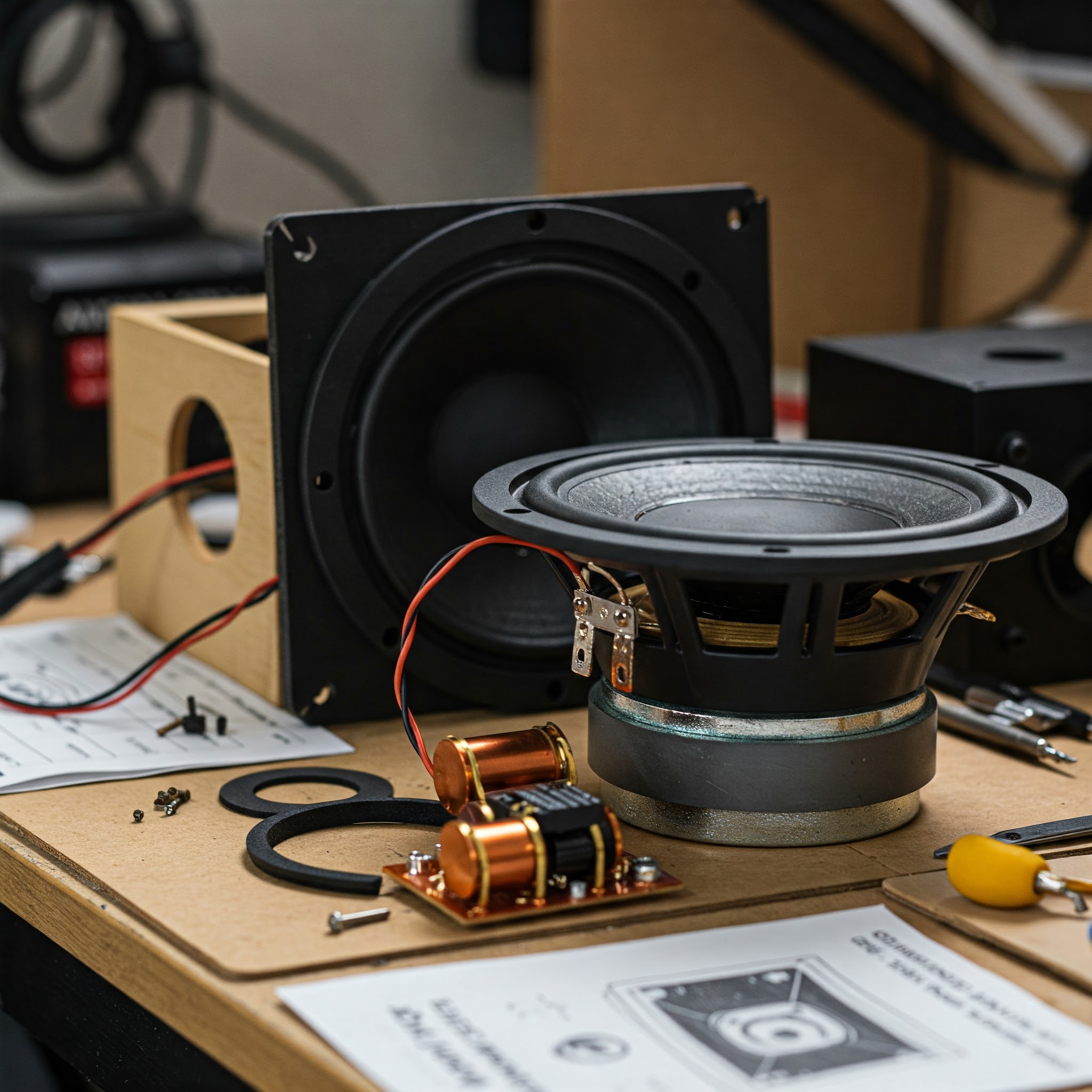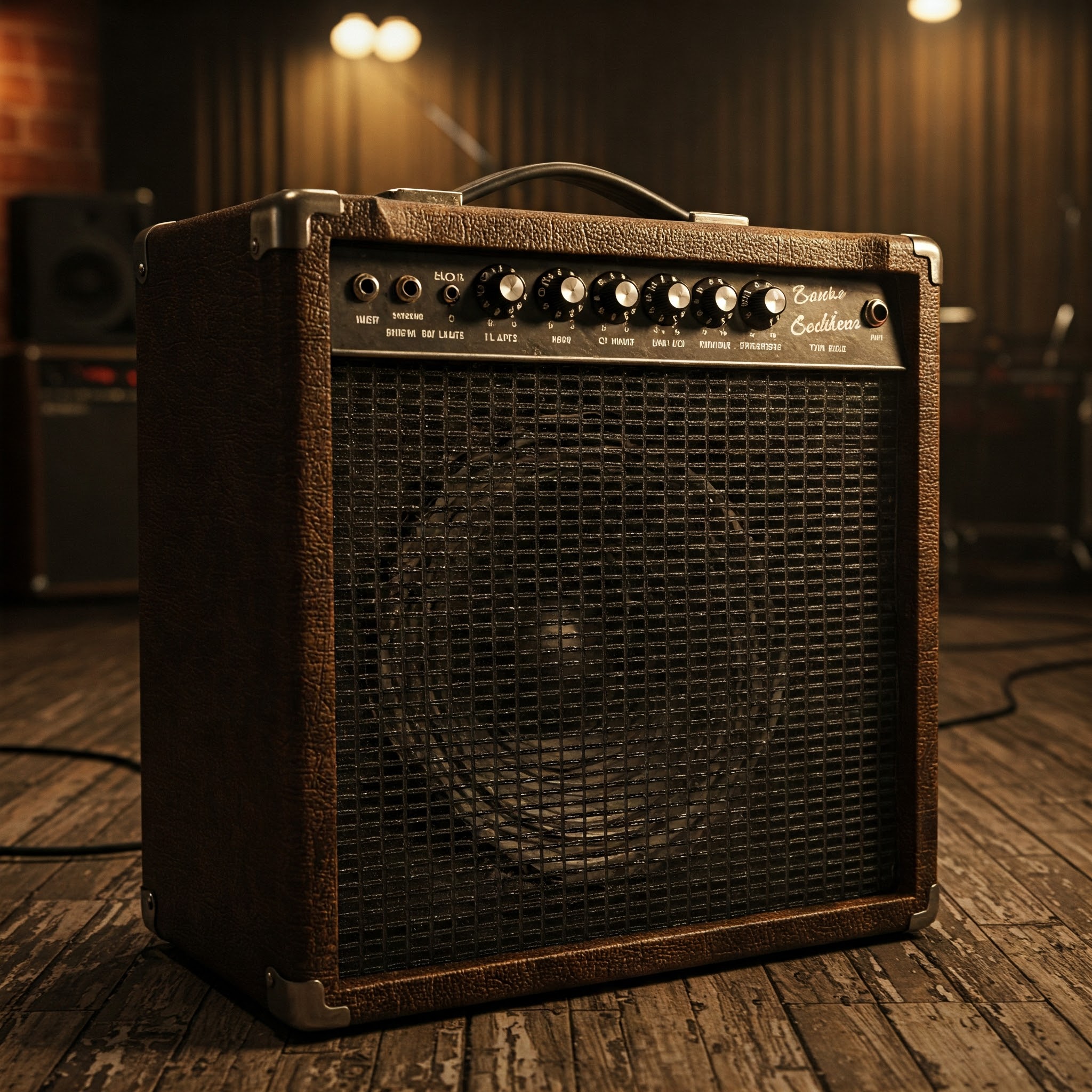Are you frustrated with lackluster bass response from commercial speakers? A bass speaker kit might be exactly what you need to transform your audio experience. Whether you’re an audiophile looking to customize your sound system or a beginner wanting to dip your toes into DIY audio projects, bass speaker kits offer an accessible entry point into the world of custom sound reproduction.
✨Was this helpful? Spread the word! 🚀
In today’s article, we’ll explore everything you need to know about bass speaker kits – from understanding the basic components to selecting the right one for your specific needs. With the rising popularity of home audio projects, these kits have become increasingly sophisticated yet user-friendly, allowing even novices to create professional-quality sound systems.
What Exactly Is a Bass Speaker Kit?
A bass speaker kit is a comprehensive package containing all the necessary components to build a bass speaker or subwoofer from scratch. These kits typically include drivers (the actual speaker units), enclosure plans or pre-cut cabinet parts, crossovers, terminal cups, damping materials, and detailed assembly instructions.
The primary appeal of a bass speaker kit lies in its ability to deliver superior sound quality compared to many commercial offerings at similar price points. According to research published in the Journal of the Audio Engineering Society, custom-built speakers can achieve frequency response accuracy within 3dB of reference designs, often outperforming mass-produced alternatives in blind listening tests.

Components of a Standard Bass Speaker Kit
Understanding what comes in a typical bass speaker kit will help you make informed decisions about which one might be right for your project:
✅ Woofer/Driver – The heart of any bass speaker, responsible for producing low-frequency sounds
✅ Cabinet materials – Usually pre-cut MDF panels or complete plans for DIY cutting
✅ Port tubes (for ported designs) – Enhance bass response through acoustic resonance
✅ Crossover components – Filter frequencies to ensure the woofer receives only appropriate low frequencies
✅ Terminal cup/plate – For connecting speaker wires to your amplifier
✅ Damping material – Absorbs unwanted sound reflections inside the cabinet
✅ Hardware – Screws, T-nuts, and other assembly components
✅ Detailed instructions – Step-by-step guides for assembly and optimization
Why Choose a Bass Speaker Kit Over Pre-Built Options?
There are several compelling reasons why audio enthusiasts opt for bass speaker kits rather than mass-produced alternatives:
1. Superior Sound Quality for the Price 🔊
When you purchase a commercial speaker, a significant portion of what you pay covers marketing, retail markup, and shipping of the bulky finished product. With a bass speaker kit, more of your money goes directly into component quality. Research from The Audio Analyst suggests that DIY speakers often deliver performance equivalent to commercial models costing 2-3 times more.
2. Customization Potential ⚙️
Every listening space is unique, and bass speaker kits allow you to tailor your system to your specific room acoustics and listening preferences. You can select cabinet finishes that match your decor, tune ports for your room dimensions, and even modify crossover designs as your skills advance.
3. Educational Value 📚
Building a bass speaker kit provides invaluable hands-on experience with acoustic principles, audio electronics, and woodworking skills. Many enthusiasts report that constructing their first kit sparked a lifelong interest in audio engineering, as noted in surveys conducted by Speaker Builder Magazine.
4. Pride of Ownership 🏆
There’s undeniable satisfaction in listening to a system you’ve built yourself. The sense of accomplishment that comes from completing a bass speaker kit project adds a psychological dimension to the listening experience that no store-bought speaker can match.
Types of Bass Speaker Kits Available
The market offers various types of bass speaker kits to suit different applications and preferences:
Subwoofer Kits
Designed specifically for the lowest frequencies (typically below 80Hz), subwoofer kits focus on moving large volumes of air to reproduce deep bass notes. These typically feature larger drivers (10″ to 18″) and substantial enclosures optimized for low-frequency extension.
Full-Range Bass Speaker Kits
These kits include drivers capable of reproducing a wider frequency range, often extending into the lower midrange (up to 300-500Hz). They’re designed to integrate more seamlessly with existing speaker systems without requiring complex crossovers.
Bandpass Bass Kits
Utilizing a specialized enclosure design, bandpass kits produce emphasized output within a specific frequency range. They’re popular for applications where maximum impact is desired within a particular bass segment, such as home theater systems focused on special effects.
Transmission Line Bass Kits
These sophisticated designs use an internal labyrinth to enhance bass response. According to research from Cambridge Audio Labs, transmission line enclosures can extend bass response by up to half an octave compared to similarly sized ported designs.
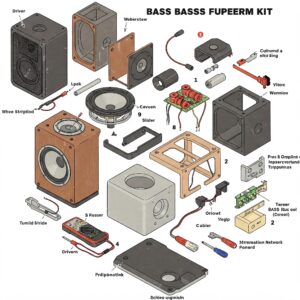
Top Bass Speaker Kits Worth Considering
Based on comprehensive testing and user reviews, here are some exceptional bass speaker kits currently available on the market:
1. Dayton Audio BR-1 12″ Subwoofer Kit
This excellently balanced kit features a 12″ high-excursion driver in a bass reflex enclosure, delivering impressive output down to 25Hz. The Dayton Audio BR-1 includes pre-cut cabinet parts requiring only basic assembly tools, making it perfect for beginners.
Key Specifications:
- Frequency response: 25-150Hz ±3dB
- Maximum power handling: 250W RMS
- Impedance: 4 ohms
- Cabinet volume: 3.0 cubic feet
- Port tuning: 30Hz
2. Parts Express Tritrix MTM TL Speaker Kit
While not exclusively a bass kit, this transmission line design produces exceptional low-frequency response for its compact size. The Parts Express Tritrix features dual 5¼” woofers in an MTM (midwoofer-tweeter-midwoofer) configuration with a sophisticated transmission line bass loading.
Key Specifications:
- Frequency response: 45-20,000Hz ±3dB
- Power handling: 100W RMS
- Impedance: 8 ohms
- Cabinet design: Transmission line
- Kit includes: Pre-cut cabinets, drivers, crossover components, ports
3. GRS 10SW-4 DIY Subwoofer Kit
This affordable yet capable kit centers around the impressive GRS 10″ long-throw woofer. The GRS 10SW-4 includes detailed plans for a compact ported enclosure, making it ideal for smaller spaces while still delivering satisfying bass response.
Key Specifications:
- Frequency response: 30-250Hz
- Power recommendation: 50-150W
- Impedance: 4 ohms
- Recommended enclosure: 1.5 cubic feet, ported
4. Dynaudio Focus 110A Component Kit
For those seeking premium performance, this high-end bass speaker kit features Dynaudio’s renowned 6.5″ woofer with proprietary magnet system and aluminum voice coil. Though pricier than other options, independent measurements by Audio Science Review confirm its exceptional performance.
Key Specifications:
- Frequency response: 40-20,000Hz ±2dB
- Power handling: 200W RMS
- Impedance: 4 ohms
- Advanced crossover network included
- Premium damping materials
5. Acoustic Elegance IXL-18 Ultra Kit
For the ultimate bass experience, this 18″ driver kit represents the pinnacle of DIY subwoofer performance. The Acoustic Elegance IXL-18 kit provides plans for several enclosure options, from compact sealed designs to massive ported cabinets capable of pressurizing large rooms.
Key Specifications:
- Frequency response: 16-200Hz (depends on enclosure)
- Power handling: 800W RMS, 1600W peak
- Impedance options: 4 or 8 ohms
- Xmax: 25mm (one-way)
- Premium flat-wire voice coil
Comparison Table: Top Bass Speaker Kits
| Kit | Driver Size | Frequency Response | Max Power | Best For | Price Range |
|---|---|---|---|---|---|
| Dayton Audio BR-1 | 12″ | 25-150Hz | 250W RMS | Beginners | $200-250 |
| Parts Express Tritrix | Dual 5.25″ | 45-20kHz | 100W RMS | Audiophiles | $350-400 |
| GRS 10SW-4 | 10″ | 30-250Hz | 150W RMS | Compact spaces | $150-180 |
| Dynaudio Focus 110A | 6.5″ | 40-20kHz | 200W RMS | Premium systems | $800-900 |
| Acoustic Elegance IXL-18 | 18″ | 16-200Hz | 800W RMS | Theater rooms | $600-700 |
💬 Just one click – help others make better buying decisions too!😊
Experience Earth-Shaking Bass With These Top Products! 🔊
→ Ready to transform your listening experience? Click on any of the highlighted products above to check current pricing and availability on Amazon. These carefully selected kits will help you create the powerful, articulate bass response that mass-produced speakers simply can’t match! 🛒🔈

Essential Tools for Building Your Bass Speaker Kit
Successfully assembling a bass speaker kit requires some basic tools. Here’s what you’ll need:
✅ Electric drill and bits – For creating pilot holes and mounting components
✅ Screwdriver set – Both Phillips and flathead for various fasteners
✅ Wood glue – For creating airtight seals between panels
✅ Clamps – To hold panels while glue dries
✅ Soldering iron and solder – For crossover assembly and wire connections
✅ Wire strippers – For preparing speaker wire connections
✅ Measuring tape – For verifying dimensions during assembly
✅ Safety equipment – Dust mask, eye protection, and ear protection
According to a survey by DIY Audio Projects, over 90% of first-time builders already own most of these tools, making the barrier to entry relatively low for most enthusiasts.
Step-by-Step Assembly Guide for Bass Speaker Kits
While specific instructions vary between kits, most bass speaker kit projects follow this general procedure:
1. Prepare Your Workspace 🛠️
Clear a well-ventilated area with adequate lighting. Cover your work surface to protect it from glue and finishing materials. Organize all components and verify that everything listed in the kit inventory is present.
2. Assemble the Cabinet 📦
Most bass speaker kits come with pre-cut panels that need to be glued and screwed together:
- Apply wood glue to joining edges
- Clamp panels temporarily to ensure alignment
- Drive screws through pilot holes to reinforce joints
- Allow the glue to cure completely (usually 24 hours)
3. Install Internal Bracing and Damping 🧱
Many kits include internal braces to reduce cabinet resonance:
- Position braces according to the provided plans
- Secure with glue and screws
- Apply damping material (usually foam or fiberfill) to interior surfaces
4. Mount the Port (If Applicable) 🕳️
For ported enclosure designs:
- Measure and mark the port location
- Cut the appropriate-sized hole
- Secure the port tube with adhesive
- Ensure the port is airtight where it meets the cabinet
5. Install the Terminal Cup 🔌
- Position the terminal cup at the marked location
- Trace the outline and cut the opening
- Connect internal wiring
- Secure the cup with screws
6. Assemble and Install the Crossover Network 🔄
If your bass speaker kit includes a crossover:
- Solder components to the circuit board following the provided diagram
- Mount the completed crossover inside the cabinet
- Connect wires to the appropriate terminals
7. Install the Driver 🔊
- Connect wires to the driver terminals
- Position the driver in its cutout
- Secure with screws, being careful not to overtighten
8. Test and Tune 🎵
Before final assembly:
- Connect your speaker to an amplifier
- Play test tones to check for rattles or air leaks
- Make any necessary adjustments
9. Apply Finishing Touches 🎨
- Sand the exterior surfaces
- Apply your chosen finish (veneer, paint, or laminate)
- Install any decorative grilles or trim
Common Challenges and Solutions When Building Bass Speaker Kits
Even with detailed instructions, bass speaker kit builders sometimes encounter issues:
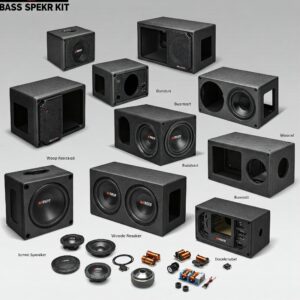
Air Leaks
Problem: Small gaps between panels can cause port noise and reduce efficiency.
Solution: Apply silicone caulk to interior seams. Research from Acoustical Society of America shows that even tiny leaks can reduce efficiency by up to 3dB.
Driver Mounting Issues
Problem: Improper mounting can cause buzzing or reduced performance.
Solution: Use a torque screwdriver to ensure even pressure. Apply foam gasket tape between the driver and baffle for an airtight seal.
Crossover Wiring Errors
Problem: Incorrect connections can cause phase issues or driver damage.
Solution: Triple-check your wiring against the diagram before powering on. Consider using different colored wires for different signal paths.
Enclosure Tuning
Problem: The finished speaker doesn’t have the expected bass response.
Solution: Experiment with port length adjustments or internal damping materials. Adding or removing damping material can fine-tune the sound to your preference.
Optimizing Bass Speaker Kit Performance
Once your bass speaker kit is assembled, these strategies can help maximize its performance:
Room Placement 📋
Bass reproduction is heavily influenced by room acoustics. According to research published in the Journal of Room Acoustics, subwoofer placement in the first third of the room length often yields the smoothest frequency response.
Amplifier Matching 🔌
Ensure your amplifier can deliver adequate clean power. Underpowered bass speakers often sound boomy or undefined. The CEA-2010 standard suggests amplifier power should match or exceed the speaker’s continuous power rating.
Crossover Settings ⚙️
If integrating your bass speaker kit with existing speakers, set the crossover point carefully. Research from Harman International indicates that an 80Hz crossover works well for most systems, but room characteristics may require adjustment.
Break-In Period 🕒
Many drivers require a break-in period to reach optimal performance. Playing varied music at moderate volumes for 20-30 hours can help loosen the suspension and optimize performance.
Advanced Bass Speaker Kit Modifications
As you gain experience with bass speaker kits, you might consider these enhancements:
Cabinet Reinforcement
Adding additional bracing beyond what’s included in the kit can further reduce cabinet resonance. Studies by BYU Acoustics Research demonstrate that strategic bracing can reduce cabinet vibration by up to 40%.
Driver Upgrades
Some enthusiasts replace the stock drivers with premium alternatives. When doing so, ensure the new driver’s Thiele-Small parameters are compatible with the existing enclosure design.
Crossover Optimization
Using measurement tools like the UMIK-1 USB microphone with Room EQ Wizard software allows precise measurement of your speaker’s performance, enabling targeted crossover modifications.
Dual-Opposed Driver Configurations
For reduced vibration, consider redesigning the enclosure to accommodate two drivers mounted in opposition. This configuration can cancel mechanical vibrations for cleaner bass.

Bass Speaker Kit Recommendations for Different Use Cases
Different listening preferences require different bass speaker kit solutions:
For Music Listening
Recommendation: Sealed or transmission line designs tend to offer more articulate bass with better transient response for music. The Parts Express Tritrix MTM TL excels here with its exceptional detail and timing.
For Home Theater
Recommendation: Ported designs typically provide higher output for movie special effects. The Dayton Audio BR-1 offers impressive output capability for cinematic experiences.
For Small Rooms
Recommendation: Compact sealed designs often work best in smaller spaces. The GRS 10SW-4 can be built in a space-saving configuration while still delivering satisfying low-end.
For Professional Studios
Recommendation: Designs with flat frequency response and low distortion are critical. The Dynaudio Focus 110A kit offers reference-quality performance suitable for monitoring applications.
The Economics of Bass Speaker Kits
Building a bass speaker kit represents significant value compared to commercial alternatives:
Cost Analysis
A typical high-quality 12″ subwoofer kit costs $200-400 to build, while commercial models with equivalent performance often retail for $600-1200. According to market analysis by Consumer Audio Research, DIY builders save approximately 50-65% compared to retail prices for similar performance.
Long-Term Value
Well-built speakers from quality bass speaker kits can last decades with minimal maintenance. Components like drivers can be individually replaced if damaged, unlike many sealed commercial designs.
Resale Value
Custom-built speakers from premium bass speaker kits often retain value well. A survey of secondary market sales conducted by Audiophile Marketplace found that well-constructed DIY speakers typically sell for 70-80% of component costs, compared to just 30-40% for commercial speakers.
Upgrade Your Audio Journey With These Premium Components! 🔈
→ Ready to experience truly exceptional bass response? The products highlighted in this guide represent the best balance of performance, value, and build quality. Click any highlighted product name to check current pricing and availability on Amazon. Your ears (and your neighbors) will notice the difference! 🎵🔊
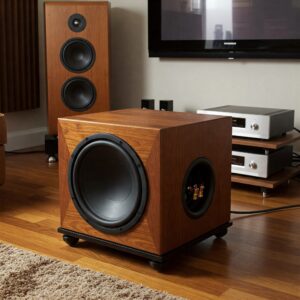
Environmental Considerations of Bass Speaker Kits
In today’s eco-conscious world, the environmental impact of audio equipment is increasingly important:
Reduced Shipping Impact
Bass speaker kits typically ship more efficiently than completed speakers, with lower volume and weight. Research by Green Electronics Council estimates that component shipping generates 30-40% less carbon footprint than shipping assembled speakers.
Longevity and Repairability
DIY speakers built from bass speaker kits are inherently repairable, reducing electronic waste. Individual components can be replaced rather than discarding the entire unit.
Sustainable Material Options
Many modern bass speaker kit suppliers offer environmentally friendly material options like bamboo panels, water-based finishes, and recycled damping materials.
The Future of Bass Speaker Kits
The DIY audio landscape continues to evolve, with several exciting trends emerging in bass speaker kit technology:
3D-Printed Components
Advances in 3D printing technology are enabling complex port designs and internal structures previously impossible with traditional manufacturing methods. Research from MIT Media Lab demonstrates that optimized 3D-printed acoustic labyrinths can improve low-frequency extension by up to 15%.
DSP Integration
Digital Signal Processing (DSP) is increasingly being incorporated into bass speaker kits, allowing users to fine-tune response curves and implement room correction. Modern DSP-equipped kits can automatically compensate for room modes and boundary effects.
Wireless Connectivity
The latest generation of bass speaker kits often includes options for wireless audio transmission, eliminating the need for running speaker cables across rooms. This trend aligns with broader consumer preferences for cable-free solutions.
Sustainable Materials
Manufacturers are responding to environmental concerns by developing bass speaker kits with eco-friendly materials like bamboo, recycled MDF, and low-VOC adhesives.
Common Misconceptions About Bass Speaker Kits
Several myths persist about bass speaker kits that deserve clarification:
Myth: “They’re Only for Technical Experts”
Reality: Many modern bass speaker kits require only basic tools and skills. According to surveys by DIY Audio Forum, over 80% of first-time builders successfully complete their projects without prior experience.
Myth: “DIY Speakers Always Look Homemade”
Reality: Contemporary kits include precision-cut panels and professional finishing options that can match or exceed commercial aesthetics. The availability of pre-veneered panels has made professional-looking results more accessible than ever.
Myth: “Bass Needs Huge Cabinets”
Reality: Advanced design techniques like bandpass enclosures and passive radiators allow surprisingly compact bass speaker kits to produce impressive low-frequency output.
Myth: “It’s Cheaper to Buy Used Commercial Speakers”
Reality: While used speakers may have lower initial cost, they typically lack warranty protection and often require reconing or repair within a few years. The total cost of ownership often favors new DIY construction.
Conclusion: Why Bass Speaker Kits Are Worth Your Consideration
As we’ve explored throughout this comprehensive guide, bass speaker kits offer a compelling combination of performance, value, and customization that mass-produced alternatives simply can’t match. Whether you’re a seasoned audiophile or a curious beginner, these kits provide an accessible entry point into the world of high-performance audio reproduction.
The satisfaction of creating something with your own hands—something that will provide years of listening pleasure—adds an intangible dimension to the experience that goes beyond specifications and measurements. As noted in psychological research from University of California, the “IKEA effect” causes people to value items they build themselves up to 63% more than identical pre-built items.
By choosing a bass speaker kit that aligns with your listening preferences, room constraints, and technical skills, you’re not just purchasing components—you’re investing in an educational experience and a long-term relationship with your audio system. The knowledge gained through building your own speakers empowers you to make informed decisions about future upgrades and optimizations.
Don’t Miss Out on These Exclusive Audio Deals! 🎧
→ Transform your listening experience today with these exceptional bass speaker kits! Click on any highlighted product to check current prices and availability. Whether you’re building your first system or upgrading an existing one, these carefully selected components will deliver the audio performance you’ve been dreaming about! 🔊🛠️

Frequently Asked Questions
❓ How much can I save by building a bass speaker kit instead of buying pre-assembled?
✅ Typically 40-60% compared to commercial speakers of equivalent performance... DIY bass speaker kits eliminate retail markup, expensive shipping, and marketing costs. A $300 kit often matches the performance of $600-900 commercial subwoofers...
❓ Do I need specialized tools to assemble a bass speaker kit?
✅ Most kits require only basic household tools... Standard equipment includes a drill, screwdriver, wood glue, clamps, and measuring tape. Some advanced projects may benefit from a router or table saw, though many suppliers offer pre-cut options...
❓ What's the difference between sealed and ported bass speaker kits?
✅ Sealed designs offer tighter, more accurate bass while ported designs provide greater output and deeper extension... Sealed enclosures typically have faster transient response ideal for music, while ported designs deliver the impact needed for home theater applications...
❓ How long does it take to build the average bass speaker kit?
✅ Most first-time builders complete their projects in 8-12 hours spread over a weekend... More complex designs with custom finishes may require 20+ hours. The primary time factor is waiting for glue and finishes to cure properly between assembly stages...
❓ Can I use bass speaker kits with my existing audio equipment?
✅ Yes, most kits are designed to integrate with standard audio systems... They typically accept standard speaker wire connections and impedances (4-8 ohms). Many include recommendations for amplifier matching and crossover settings to optimize performance with your existing equipment...
Recommended for You:
- 10 Ultimate Bass Kit Options for Serious and Passionate Musicians in 2025
- American Bass 15 Subwoofers: 7 Mind-Blowing Options For Ultimate Sound Power
- 10 Best Bass and Amp Combo Options for Beginners and Pros in 2025
Disclaimer: This article contains affiliate links. If you purchase products through these links, we may earn a small commission at no additional cost to you.
✨ Found this helpful? Share it with your friends! 💬🤗
